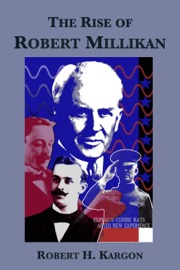 $9.99 on Kindle, Nook, Apple Books, Kobo, Google Play
$9.99 on Kindle, Nook, Apple Books, Kobo, Google Play(cover by Jeremy Kargon)
The Rise of Robert Millikan: Portrait of a Life in American Science by Robert H. Kargon (59,000 words, 20 illustrations)
“I do not consider myself to be Robert Millikan’s biographer. This book is not a full record of Millikan’s life or even of his scientific career. It is an essay, very selective, on themes that are illustrated and illuminated by Millikan’s life in American science. It is, as well, a portrait of the development of a scientist...
Robert Millikan was among the most famous of American scientists; to the public of the 1920s, Millikan represented science. The first American-born physicist to win the Nobel Prize, Millikan was a leader in the application of scientific research to military problems during World War I and a guiding force in the rise of the California Institute of Technology to a preeminent place in American scientific education and research. His life is therefore peculiarly suited to illuminate and provide texture for the vast changes that have taken place in science during the twentieth century. In this extended essay, I employ the biographical mode to explore several important aspects of this theme. Millikan was successively a teacher, researcher, administrator, entrepreneur, and sage. By describing the novel roles that he assumed, I suggest how science grew in complexity and carved out an essential place for itself in our general culture.” — Robert H. Kargon, Preface to The Rise of Robert Millikan: Portrait of a Life in American Science
“Professor Kargon... has given us a sympathetic account of Millikan’s scientific career, including his great triumphs, his rearguard actions to defend untenable positions, and the eventual rejection or revision of every major result or standpoint. But he is more concerned with Millikan’s influence on the developing American physics community and with Millikan’s role in advancing American science generally and American higher education... Together with the chemist A.P. Noyes and the astronomer G.E. Hale, Millikan... believed in an American scientific destiny... This picture of American science is presented with great insight, tremendous learning, and wit... Professor Kargon’s book strikes a happy balance between being an interpretive story of a scientific life and a social history of science in America. Every reader interested in science or in the place of science in society will come away from this book with new information, important insights and a better understanding of the growth of scientific ideas and institutions in the twentieth century.” — I. Bernard Cohen, Nature
“With the publication of this volume by Kargon, readers now have new and valuable access to much material about Millikan that was previously unavailable... Kargon states that he is not writing a biography of Millikan but rather a portrait of the man and the scientific scene in early 20th-century America... he has succeeded well in this endeavor... the book is well written, and readers who are already reasonably conversant with 20th-century developments in physics will find much that is illuminating... a genuine contribution to the history of science.” — Katherine R. Sopka, American Scientist
“[H]ere is an admirable piece of work... Kargon has not sought to make his readers like his subject, but only to understand his scientific style, his achievements, and his character, and to perceive how his life was ‘a microcosm of new roles assumed by the scientist during the course of the twentieth century’... Kargon’s [...] insights [are] important, and his book [is] deserving of a careful study. “ — Robert C. Post, The American Historical Review
“A useful corrective to Millikan’s self-portrait that reveals some of the blemishes, as well as the embellishments, of an important life in American science.” — Robert W. Seidel, Science
“For over thirty years, the only overview of Millikan’s life available to the layman was his own selective autobiography. That book either omitted or told only one side (sometimes biased by hindsight) of many important controversial episodes associated with his achievements and views... Kargon’s portrait-essay deals with some of these neglected incidents in a well-written and coherent manner aimed at a wide readership.” — John L. Michel, Technology and Culture
“A very readable work with the virtue of containing a great deal of information in a brief compass. Kargon’s book deserves and will receive a wide audience as the successor to its subject’s autobiography... [Kargon] also merits credit for interesting discussions on Millikan as a statesman, administrator, and spokesman for science... a clearly first-rate narrative...” — Nathan Reingold, Isis
“Admirably, Kargon combines institutional with intellectual history... Kargon offers a fascinating discussion of Millikan’s and George Hale’s contributions to war research, the California Institute of Technology, and the Mount Wilson Observatory. Kargon rightly stresses the collaborators’ links with the leaders of finance and industry developing Los Angeles... as a brief sketch of Millikan the scientific institution builder, Kargon’s book deserves the wide audience he seeks.” — Peter Galison, The Journal of American History
“The book leaves us in no doubt about [Millikan’s] ability, but does not gloss over his occasional obstinacy or his wishful thinking about past errors, matters on which some histories tend to be silent. Millikan was not a revolutionary who started new ideas, but the author stresses — rightly — the importance of men like him for the progress of science.” — Rudolf Peierls, The New York Review of Books
“A gem of a book — thought-provoking, insightful, highly interesting reading.” — Lawrence Badash, University of California, Santa Barbara
“The author skillfully weaves the story of Millikan with the story of modern science in a book that will be well received by a variety of audiences from professional historians of science to the general public.” — Choice
“Kargon’s background in physics serves him well in placing Millikan’s work in its theoretical context, in the analysis of the work itself, and in generally managing to capture both the intense excitement and the routine involved in testing the ideas of the giants of that period in physics... Kargon... has certainly opened enough questions in this perceptive work — in addition to the large number that he has settled; and he has demonstrated an important use for the biographical mode. The general American historian as well as the historian of science can profit from reading this volume.” — George H. Daniels, The Historian
“Robert Millikan’s scientific career, his character, and his roles as teacher, administrator at the California Institute of Technology, entrepreneur, and public figure are the topics covered in this biography. Even in discussing Millikan’s later decline as a front-line scientist, author Robert Kargon treats the scientist with compassion and fairness and portrays him as a many-faceted, often controversial man with doubts and uncertainties at the height of his fame... The high school physics student will find this book engaging and insightful in its description of a scientist struggling with science, self, and society.” — A. Cordell Perkes, The Science Teacher
“[V]ery well researched and written. Robert Kargon gives an excellent picture of the rise of American physics, from the years when every aspiring young American physicist wanted to go to Germany to study, to the years when every aspiring young European physicist wanted to come to the United States for the same purpose. He clearly understands science, yet knows how to present its history so that it is interesting and meaningful to non-scientists. He tells not only of Millikan’s triumphs, but of his doubts as well; of his discoveries, and also of his mistakes... All in all, this is an excellent book, strongly recommended to the reader who is interested in the history of American science, and in the life of an outstanding practitioner of it.” — Donald E. Osterbrock, The Wisconsin Magazine of History



